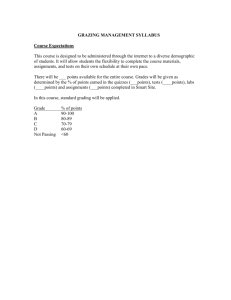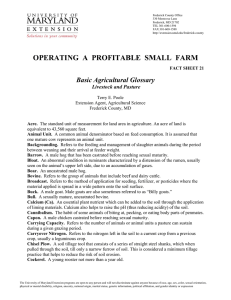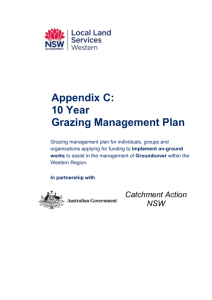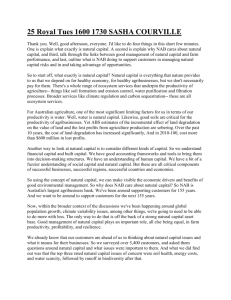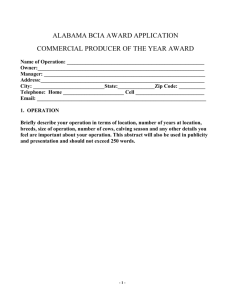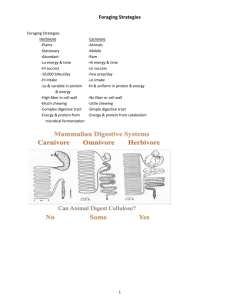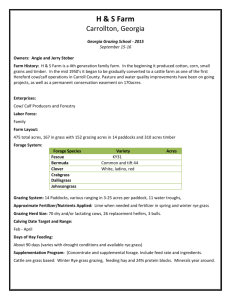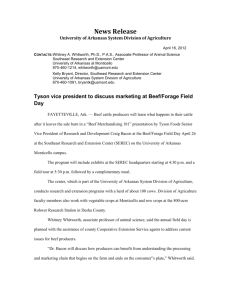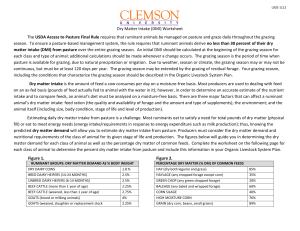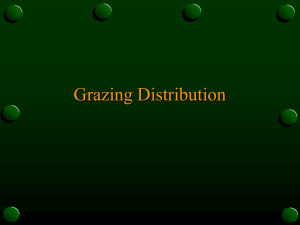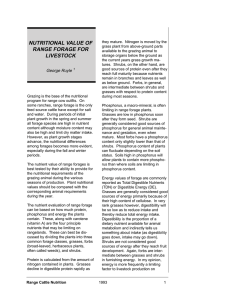Basic Concepts of Management-Intensive Grazing
advertisement
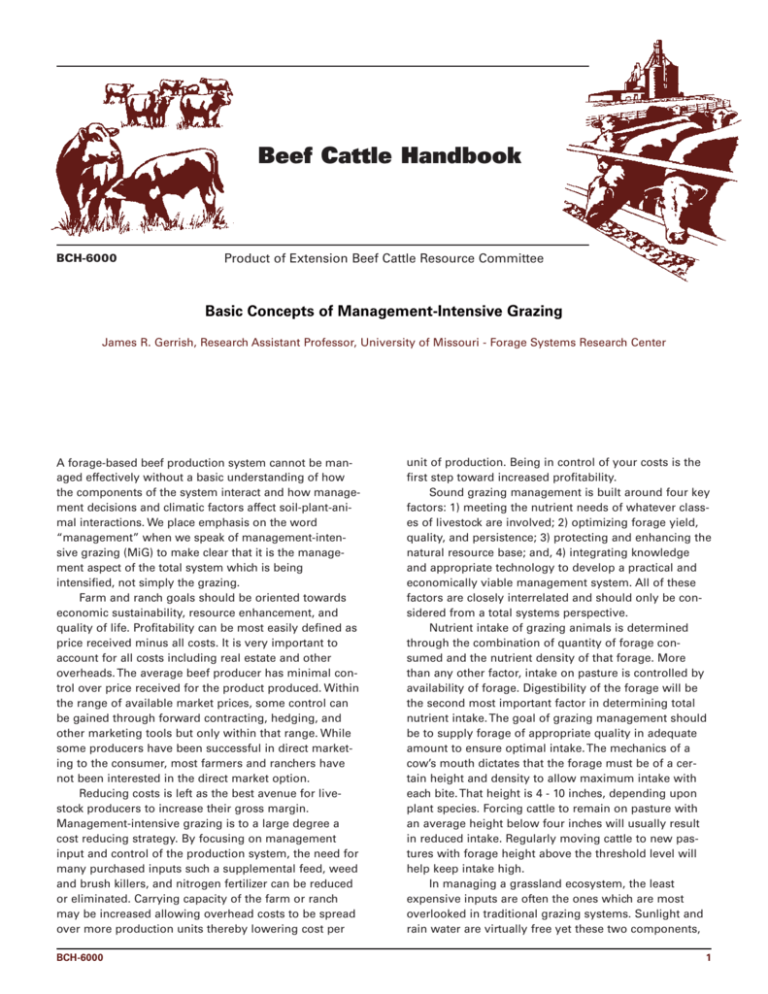
Beef Cattle Handbook BCH-6000 Product of Extension Beef Cattle Resource Committee Basic Concepts of Management-Intensive Grazing James R. Gerrish, Research Assistant Professor, University of Missouri - Forage Systems Research Center A forage-based beef production system cannot be managed effectively without a basic understanding of how the components of the system interact and how management decisions and climatic factors affect soil-plant-animal interactions. We place emphasis on the word “management” when we speak of management-intensive grazing (MiG) to make clear that it is the management aspect of the total system which is being intensified, not simply the grazing. Farm and ranch goals should be oriented towards economic sustainability, resource enhancement, and quality of life. Profitability can be most easily defined as price received minus all costs. It is very important to account for all costs including real estate and other overheads. The average beef producer has minimal control over price received for the product produced. Within the range of available market prices, some control can be gained through forward contracting, hedging, and other marketing tools but only within that range. While some producers have been successful in direct marketing to the consumer, most farmers and ranchers have not been interested in the direct market option. Reducing costs is left as the best avenue for livestock producers to increase their gross margin. Management-intensive grazing is to a large degree a cost reducing strategy. By focusing on management input and control of the production system, the need for many purchased inputs such a supplemental feed, weed and brush killers, and nitrogen fertilizer can be reduced or eliminated. Carrying capacity of the farm or ranch may be increased allowing overhead costs to be spread over more production units thereby lowering cost per BCH-6000 unit of production. Being in control of your costs is the first step toward increased profitability. Sound grazing management is built around four key factors: 1) meeting the nutrient needs of whatever classes of livestock are involved; 2) optimizing forage yield, quality, and persistence; 3) protecting and enhancing the natural resource base; and, 4) integrating knowledge and appropriate technology to develop a practical and economically viable management system. All of these factors are closely interrelated and should only be considered from a total systems perspective. Nutrient intake of grazing animals is determined through the combination of quantity of forage consumed and the nutrient density of that forage. More than any other factor, intake on pasture is controlled by availability of forage. Digestibility of the forage will be the second most important factor in determining total nutrient intake. The goal of grazing management should be to supply forage of appropriate quality in adequate amount to ensure optimal intake. The mechanics of a cow’s mouth dictates that the forage must be of a certain height and density to allow maximum intake with each bite. That height is 4 - 10 inches, depending upon plant species. Forcing cattle to remain on pasture with an average height below four inches will usually result in reduced intake. Regularly moving cattle to new pastures with forage height above the threshold level will help keep intake high. In managing a grassland ecosystem, the least expensive inputs are often the ones which are most overlooked in traditional grazing systems. Sunlight and rain water are virtually free yet these two components, 1 along with soil productivity, are the main determinants of forage production. Lack of productivity on much of the pasture land of the Midwest is directly related to amount of leaf cover present on a per acre basis at any point in time. Photosynthesis only occurs in green, growing leaves. If few leaves are present, little energy is being produced for harvest by grazing animals. Bare soil in a pasture is an indication of lost beef production. The first step to increasing pasture productivity is to grow more leaves both in the sense of physical space and over time. To grow more leaves per acre, a vigorous, diverse plant community is essential. Plants must have an opportunity to rest and grow new leaves in order to maintain optimal production. A diverse plant community will provide green leaves more days of the year than will a single species pasture. More than anything, a simple rotational grazing system provides rest for the pasture plants. Many other symptoms of poor pasture productivity, such as weed invasion, soil erosion, soil compaction, and poor quality stock water in ponds are also the product of inadequate leaf cover on the pasture. Above ground leaf area is directly proportional to the quantity of roots below ground. Poor leaf cover mean poor root development. Poor root development means inadequate water infiltration, excessive runoff, and increased likelihood of drought stress. Increasing leaf area will not only increase the harvest of sunlight, but also increase the harvest of rain or irrigation water . Soil, the other prime determinant of forage production, on the other hand is not free. The cost of land may be quite high and when a producer buys a piece of land, what he/she is really purchasing is the soil productivity of that acre. The soil resource may be degraded or enhanced depending upon the management strategies imposed. Grazing that severely restricts leaf growth and will also deplete soil organic matter and further reduce potential productivity. Grazing management that encourages leaf development will encourage root development and the increase of soil organic matter. Increased soil organic matter will lead to better water infiltration and higher water holding capacity in the soil. Pasture productivity will ultimately increase in the presence of increased organic matter. While management-intensive grazing strategies optimize the efficient harvest of sunlight and water and enhance the soil resource, rather than rely upon technological “fixes” to support production goals, some modern tools are essential to the practice of good grazing management. Water system development to manage grazing distribution is critical to success. Fencing to control livestock movement is part of management. Knowing when to fertilize, control weeds and brush, or interseed new species is essential to sound grassland management. No tool should be used in every case, but no tool should be prematurely rejected. Summary Management-intensive grazing is a goal driven approach to forage-livestock management. Production goals should take the form of economic return per acre or per animal rather than arbitrary measurements of animal output. Most economic analyses find little or no relationship between traditional measurements of production such as average weaning weight and actual farm profitability. Another goal of land management is to actually enhance the natural resource base rather than simply conserving it. Making the land better for the next generation has been the goal of many generations of farmers over the centuries. In modern agriculture, that objective has sometimes fallen by the wayside in the struggle to simply survive. One of the reasons why many young people have forsaken coming back to the farm is the view that farm life is one day of drudgery followed by another. Farming needn’t be that way and a final goal of the production system should be to provide a comfortable quality of life. To be successful, it is more important to work smarter than to just work harder. Author: James R. Gerrish, Research Assistant Professor, University of Missouri - Forage Systems Research Center This publication was prepared in cooperation with the Extension Beef Cattle Resource Committee and its member states and produced in an electronic format by the University of Wisconsin-Extension, Cooperative Extension. Issued in furtherance of Cooperative Extension work, ACTS of May 8 and June 30, 1914. BCH-6000 Basic Concepts of Management-Intensive Grazing 2 Beef Cattle Handbook
